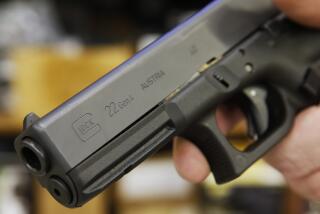Opinion: Want to help prevent school shootings? Build safer campuses.
- Share via
We have all lived through tragic moments in history that have impacted our lives, consciously or subconsciously. My mother was the one who explained this concept to me, saying she never forgot exactly what she was doing when she learned that JFK had been shot. It was an instance of tragedy and shock that stays frozen in time for her, and makes even the smallest occurrences of the day seem monumental. There have been collective tragedies like that in my life as well, but perhaps none more poignant than the barrage of school shootings we’ve seen in recent years.
For me, the 1999 Columbine school shooting stands out in what has become a grotesque epidemic of gun violence within educational institutions. Of course, this was not the first school shooting to occur and was unfortunately not the last, but the Columbine incident held its own significance in that it underscored the need to identify and address the fundamental causes of these mass killings within schools to prevent more of them.
While progressive steps have been made since Columbine to prevent school shootings, they continue to occur. As a father, and as an architect who works with educators and parents, tragedies like this hit close to home.
I can only imagine how horrific it would be to lose a child in such an inexplicable way. Watching the news coverage of the recent Isla Vista killings, I was moved by the comments made by Richard Martinez, the father of one of the victims.
“No parent should have to go through this,” he said in an interview with CNN. “What has changed; have we learned nothing? These things are going to continue until somebody does something. So where the hell is the leadership?”
Witnessing the pain that parents such as Martinez have gone through, feeling the collective shock of Columbine, Virginia Tech and the Sandy Hook massacres, not to mention the profusion of other school shootings that did not receive the media attention and national empathy they deserved, has continued to fuel my desire to build safer schools and further educate school districts about the importance of safety in what I call “21st century learning environments.”
One of the big things I have found to be extremely important for creating safe learning environments is receiving input from the community. At BCA Architects, we begin every school project by polling parents, teachers, administrators and even law enforcement officials (such as SWAT teams) to collaboratively address each specific community’s concerns and build a consensus on specific solutions.
The beautiful thing about this? Everyone wants to help prevent tragedies from occurring, and the feedback is extremely helpful to the design team. In one town, a group of individuals from the senior center volunteered to do a neighborhood watch. This effort may deter would-be assailants, and it also offers much more comfort to a child’s psychology than having security guards pat down students at entrances.
Here are a few things I have learned to look at since the Columbine shooting that I hope schools across the globe will consider to create safer environments:
- Ensure the school’s administration building is positioned in a key location on the campus to facilitate visual connectivity to everyone coming and going from the school and to provide better control of the campus.
- Create a single point of access when the school is in session. This is fundamental to the protection of the students and staff and can be accomplished by aesthetically pleasing fencing and by using buildings as barriers to prevent intruders from gaining access to the campus.
- Add high-resolution/definition security cameras throughout the school to visually control all areas of the campus, including the athletic fields, to monitor potential intruders. In addition to keeping administrative offices informed and in control, it offers the local police department the opportunity to also monitor the campus.
- Implement smart innovations in school construction. Doors and windows can provide greater safety for children and teachers in classrooms. The so-called Columbine lock, for example, allows classroom doors to be locked from the inside in the event of an intruder or lockdown on campus. Hardened glass placed at the entry of the administrative office creates a buffer to prevent a shooter from easily entering the site (reference Sandy Hook). And locating windows at a higher level on exterior buildings prevents easy intrusion without compromising natural daylight.
Although we can never fully keep our students out of harm’s way, I think educators and designers can take into account the thoughts I have listed above and begin to pave the way to a safer tomorrow, and to avoid future tragedies.
Paul Bunton is president of BCA Architects.
More to Read
A cure for the common opinion
Get thought-provoking perspectives with our weekly newsletter.
You may occasionally receive promotional content from the Los Angeles Times.






